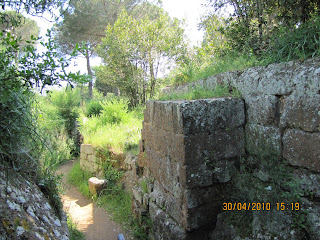There, I feel better now. So, after a false start yesterday, we decided to try Cerverteri today. Getting there proved to be a bit of an adventure in it's self. The train trip itself was a breeze. We arrived at Ladispoli station and from there we had to take a bus to Cerverteri. After having lunch we got our bus tickets and were ready to go. But which bus? We sat for a while waiting for the local bus, and when they finally came, we found out we were waiting for the wrong bus service. Finding the correct service stop proved to be the adventurous part of the day. Being a small city, the stops are not clearly marked, but asking a lot of people and deciphering the hand gestures indicating which twists and turns to take in the road, making a few miss turns we finally found the bus stop. After a considerable wait a bus finally came along, but when we asked the driver he said he was not going there. So we wait for another bus, this one comes and is clearly marked with our destination, so on we get. On gets a ticket checker, and when we ask her how many stops before our city, she says it is the end of the line BUT we are going the wrong way!!! We're headed to ROME. She directs us to the right stop. The first bus comes by, we ask if they are going to the "Necropoli", they say no, so we don't get on. Another wait, another bus with the right signage , so we decide, let's go for it. Well they didn't go to the necropolis but they did go to Cerverteri. We finally arrived!! Then it was a shuttle bus to the site.
Finally we get to see where dead people lived before they went to the underworld.
Near Cerverteri, was once an Etruscan community. There is documentation of a community here from about the 9th century BC to about the 3rd century BC. The Etruscans were a fascinating people. Historian seem to be uncertain about where they came from, were they local, did they migrate from Persian when a prolonged famine struck, did they come from Egypt or Greece? No decisive evidence appears to indicate just where they originated. They were a highly intelligent group of people, their artifacts indicate that they lead a fairly comfortable life style with many beautiful art objects, jewelry, frescoes and carved objects found. What has been discovered is that they, like the Egyptians, appeared to believe in an afterlife, as is witnessed by their tombs that contained all the items one would need on a trip to the after world; food possessions etc. This site is about 1000 acres in size but only about 25 acres have been excavated.
Initially it appears that some cremation took place as a series of buried jars which contained funerary urns were found, and walls of niches with urns are also scattered across the site. Of greatest interest are the large tombs which were built of tuffa (a porous volcanic rock found on site). Initially these tombs seemed to be randomly placed but at a later date they became more organized with the city of the dead being built to parallel the city of the living with the tombs being arranged in a street grid layout.
The tombs themselves were carved down into the solid rock. The perimeter rock that was removed from the outside of these round tombs was later used to form the domed roof. There were stairs leading down into the chambers, hallways, entry rooms, storage rooms, and of course rooms for the bodies waiting transport to the underworld. The tomb building seems to have been used over several centuries with more family chambers being added over time. Some of these structures were very deep, with a couple of them that we entered being 30 steps underground before you came to the chambers. In front of each chamber were markers indicating the number of male and female corpses buried within. The male was indicated by a vertical column, the female was represented by a house shaped or square blocked stone. Inside the chambers the beds that these corpses lay on also indicated their gender. The female beds had a rounded pillow area while the man's bed had a peaked roof like structure at the pillow end. Although I couldn't tell, apparently the bodies were orientated so they faced the southeast. In one chamber, I counted beds for 16 individuals.
Can you tell I was very intrigued by this site?!? I find touring old cemeteries to be absolutely fascinating because you get an understanding of what is important to the people of the time by what their funeral rituals involved. And this is the oldest graveyard I have had and probably will ever have to visit.
Etruscan jewelry has always intrigued me, and now I think I know why - they were a fascinating people.
Enough words, now some pictures
Burial urns and wall of burial niches
A domed burial chamber and the entrance in
Layout of a burial chamber
a storage niche
a bed for a male
a female bed (note the built in pillow)
It's along way down to the entrance, 30 steps to be exact
Well worth the trip - could not go in but got pics thru glass
Room for eight
Windows into bed chambersSquare tomb
It's a long way down there
Street of tombs
Tracks made by funerary carts over the years
Ceilings of some tombs
Remnants of bands of color
Honey, I've found our spot
Streets of tombs
400 year old oak tree
Artifacts from various tombs

Funeral Urns
Two tourists seldom seen in a picture together





















































